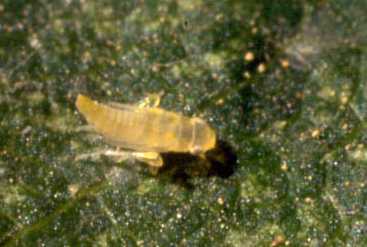White Apple Leafhopper
General Description
Hosts
Apple, pear, prune plum
Damage
Leaves - Feeding of nymphs and adults causes white to yellowish stippling of the leaves (Fig. 1).
| Figure 1. White apple leafhopper feeding damage to apple leaves. (BCMA) |
Fruit - Remove brown specks of leafhopper excrement on skin by washing or wiping; excrement around stem base is difficult to remove. Leafhopper damage to leaves does not affect fruit colour or size; however, high populations may affect newer apple varieties that are sensitive to stress.
If very numerous, leafhoppers may be a nuisance to fruit thinners and pickers.
Identification
Nymph - White to pale yellow-green, elongated with rounded head and pointed hind end (usually curved upwards), 1-2.5 mm long (Fig. 2).
 |
| Figure 2. White apple leafhopper nymph. (BCMA) |
Adult - Yellowish-white, 3 mm long, with wings held roof-like over body (Fig. 3).
| Figure 3. Adult white apple leafhopper. (BCMA) |
Life History
White apple leafhoppers overwinter as eggs inserted in the bark of twigs, branches and water sprouts. Egg hatch begins during bloom. Nymphs feed on leaves until they become adults in June. New adults insert eggs into the midribs of leaves. Second generation nymphs appear in late July to mid-August and mature into adults, which lay overwintering eggs. The first hard frost in the fall kills adults.
Monitoring
Counting nymphs on the undersides of randomly selected leaves from a number of trees will give an estimate of average population density per block. Begin monitoring about mid-May (first generation) and again in mid-July (second generation).
Management
Cultural Control
Avoid excessive nitrogen applications to reduce succulent growth and thereby limit development of leafhopper populations.
Chemical Control
If leafhoppers were a problem the previous year and leafhopper nymphs are easily found on leaves, chemical control may be warranted. Admire, Assail, Clutch, Calypso and Exirel are most effective when applied against first-generation nymphs just before adults appear (usually petal- fall or later). Research shows neonicotine products such as Assail can cause mite populations to increase. Therefore do not apply more than two applications of Assail per season regardless of target pest (codling moth, aphids, leafhoppers, leafminers) to avoid possible mite flare-up. Assail and Calypso applied when codling moth is laying eggs will aid in control of codling moth.
Sevin applied for fruit thinning will also control leafhoppers. Because Sevin can harm predatory mites, monitor mite population levels in blocks treated with Sevin for fruit thinning and with Assail for leafhopper control. This is especially important if you use Sevin and Assail in successive years.
